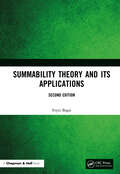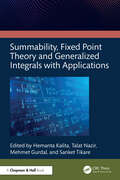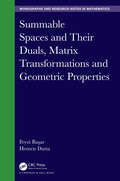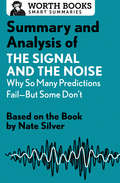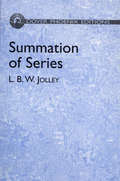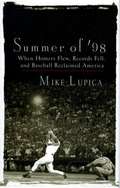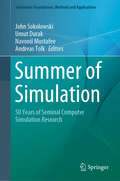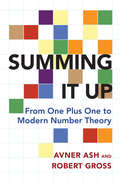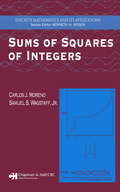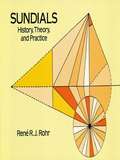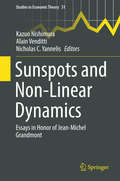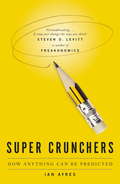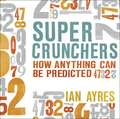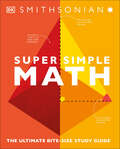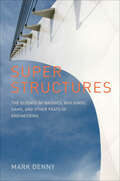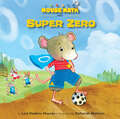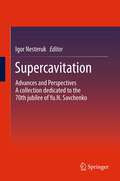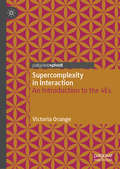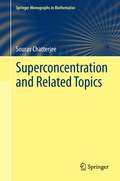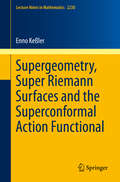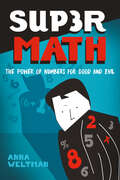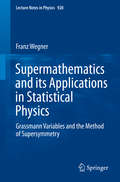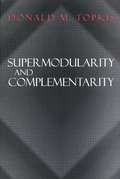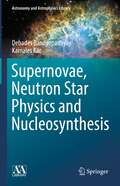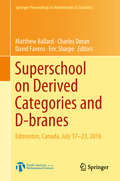- Table View
- List View
Summability Theory and Its Applications: Topics In Modern Summability Theory (Mathematics And Its Applications Ser.)
by Feyzi BaşarSummability Theory and Its Applications explains various aspects of summability and demonstrates its applications in a rigorous and coherent manner. The content can readily serve as a reference or as a useful series of lecture notes on the subject. This substantially revised new edition includes brand new material across several chapters as well as several corrections, including: the addition of the domain of Cesaro matrix C(m) of order m in the classical sequence spaces to Chapter 4; and introducing the domain of four-dimensional binomial matrix in the spaces of bounded, convergent in the Pringsheim's sense, both convergent in the Pringsheim's sense and bounded, and regularly convergent double sequences, in Chapter 7. Features Investigates different types of summable spaces and computes their dual Suitable for graduate students and researchers with a (special) interest in spaces of single and double sequences, matrix transformations and domains of triangle matrices Can serve as a reference or as supplementary reading in a computational physics course, or as a key text for special Analysis seminars.
Summability, Fixed Point Theory and Generalized Integrals with Applications
by Sanket Tikare Hemanta Kalita Talat Nazir Mehmet GurdalThis book presents contemporary mathematical concepts and techniques including theories of summability, fixed point and non-absolute integration and applications, providing an overview of recent developments in the foundations of the field as well as its applications. It discusses the recent results of double sequence spaces as the four-dimensional forward difference matrix in double sequence spaces, several new fixed point on Hadamard type fractional integral and differential operator related to the qualitative properties of solutions like, existence and uniqueness, stability, continuous dependence, controllability, oscillations, etc. It also includes several new areas of nonabsolute integration theory are introduced and their applications to other fields. This reference text is for researchers, academics, and professionals in the field of pure and applied mathematics. Covers recent research breakthroughs in this field offering new approaches and methods for both theoretical exploration and practical application Presents insights into functional analytic methods in summability, absolute and strong summability, direct theorems on summability, special and general summability methods, and their applications Highlights fixed-point theory’s application to real-world problems and offers solutions to various complex challenges Introduces new areas of non-absolute integration theory, such as the Henstock-Kurzweil integral and generalized Riemann integral Discusses sequence spaces and functional analysis, including the exploration of double sequence spaces and the four-dimensional forward difference matrix, offering valuable contributions to ongoing research
Summable Spaces and Their Duals, Matrix Transformations and Geometric Properties (Chapman & Hall/CRC Monographs and Research Notes in Mathematics)
by Hemen Dutta Feyzi BaşarThe aim of Summable Spaces and Their Duals, Matrix Transformations and Geometric Properties is to discuss primarily about different kinds of summable spaces, compute their duals and then characterize several matrix classes transforming one summable space into other. The book also discusses several geometric properties of summable spaces, as well as dealing with the construction of summable spaces using Orlicz functions, and explores several structural properties of such spaces. Each chapter contains a conclusion section highlighting the importance of results, and points the reader in the direction of possible new ideas for further study. Features Suitable for graduate schools, graduate students, researchers and faculty, and could be used as a key text for special Analysis seminars Investigates different types of summable spaces and computes their duals Characterizes several matrix classes transforming one summable space into other Discusses several geometric properties of summable spaces Examines several possible generalizations of Orlicz sequence spaces
Summary and Analysis of The Signal and the Noise: Based on the Book by Nate Silver (Smart Summaries)
by Worth BooksSo much to read, so little time? This brief overview of The Signal and the Noise tells you what you need to know—before or after you read Nate Silver&’s book. Crafted and edited with care, Worth Books set the standard for quality and give you the tools you need to be a well-informed reader. This short summary and analysis of The Signal and the Noise by Nate Silver includes: Historical contextChapter-by-chapter summariesImportant quotesFascinating triviaGlossary of termsSupporting material to enhance your understanding of the original work About The Signal and the Noise by Nate Silver: Drawing on groundbreaking research, The Signal and the Noise, written by the founder and editor-in-chief of FiveThirtyEight.com, examines how data has been used in prediction and forecasting, and how to find the true signals—the points that indicate that something will happen—amidst noisy and distracting data. Addressing different fields of forecasting and predictions—from politics to earthquakes to poker—Silver explores the reasons why some things are easier to forecast, like the weather, while others are so difficult, such as terrorism. From one of the country&’s smartest thinkers. The Signal and the Noise provides vital insights into how to think about probability and predictions on the economy, climate change, sports, and other subjects that impact our lives. The summary and analysis in this ebook are intended to complement your reading experience and bring you closer to a great work of nonfiction.
Summation of Series
by L.B. W. JolleyOver 1,100 common series, all grouped for easy reference. Arranged by category, these series include arithmetical and geometrical progressions, powers and products of natural numbers, figurate and polygonal numbers, inverse natural numbers, exponential and logarithmic series, binomials, simple inverse products, factorials, trigonometrical and hyperbolic expansions, and additional series. 1961 edition.
Summer of '98: When Homers Flew, Records Fell, and Baseball Reclaimed America
by Mike LupicaIn the summer of '61, Mike Lupica's father left notes for him in the night: Maris hit another, Mantle two-for-four, Yanks won. That was his first golden summer. He thought there'd never be another one like it -- until the "Summer of '98", when he found himself leaving notes for his own sons: Sosa hit another, McGwire hit one back. And the Yanks won. In 1998, the conversation of the country was about baseball again, as the taste of the 1994 strike was finally washed away in a sweet flood of glory. With humor and feeling, Lupica recaptures that season, but not in any ordinary way. In Fargo, North Dakota, Roger Maris's boyhood best friend watches McGwire hit 62. In Washington Heights, New York City, the scout who saw Sammy Sosa get off the bus from Santo Domingo celebrates, along with half a million Dominicans. The Little League champions from Toms River stand in awe on the field at Yankee Stadium; Joe DiMaggio talks as he watches the Yankees have the kind of year he always had; Cal Ripken speaks from the past about how he always intended his streak to end; a divorced father watches with a lump in his throat as McGwire lifts his son at home plate. David Wells, Kerry Wood, Shane Spencer, Ken Griffey, Jr. -- all the boys of summer come alive in unique and special ways, as we're reminded, for one season at least, that, yes, they do play baseball like they used to.
Summer of Simulation: 50 Years of Seminal Computer Simulation Research (Simulation Foundations, Methods and Applications)
by Andreas Tolk Umut Durak Navonil Mustafee John SokolowskiThis book is based on the “Summer Simulation Multi-Conference” (SCSC), which has been a prominent platform for the dissemination of scholarly research in the M&S community for the last 50 years. In keeping with the conference’s seasonal title, the authors have called this half-century “the summer of simulation,” and it has led not only to simulation-based disciplines but also simulation as a discipline. This book discusses contributions from the SCSC in four sections. The first section is an introduction to the work. The second section is devoted to contributions from simulation research fellows who were associated with the SCSC, while the third section features the SCSC’s most influential contributions. Lastly, the fourth section includes contributions from the best papers in the last five years.Features:• A comprehensive volume dedicated to one of the simulation domain’s major conferences: the SCSC• Offers a scientometric analysis of the SCSC• Revisits high-impact topics from 50 years of the SCSC• Includes chapters by simulation research fellows associated with the SCSC• Presents updated best-paper contributions from the recent conferenceThis work will be of value to anyone interested in the evolution of modeling and simulation over the last fifty years. Readers will gain a perspective on what drove this evolution, and develop an understanding of the key contributions that allowed this technology to grow into its own academic discipline and profession.
Summing It Up: From One Plus One to Modern Number Theory
by Robert Gross Avner AshWe use addition on a daily basis--yet how many of us stop to truly consider the enormous and remarkable ramifications of this mathematical activity? Summing It Up uses addition as a springboard to present a fascinating and accessible look at numbers and number theory, and how we apply beautiful numerical properties to answer math problems. Mathematicians Avner Ash and Robert Gross explore addition's most basic characteristics as well as the addition of squares and other powers before moving onward to infinite series, modular forms, and issues at the forefront of current mathematical research. Ash and Gross tailor their succinct and engaging investigations for math enthusiasts of all backgrounds. Employing college algebra, the first part of the book examines such questions as, can all positive numbers be written as a sum of four perfect squares? The second section of the book incorporates calculus and examines infinite series--long sums that can only be defined by the concept of limit, as in the example of 1+1/2+1/4+. . .=? With the help of some group theory and geometry, the third section ties together the first two parts of the book through a discussion of modular forms--the analytic functions on the upper half-plane of the complex numbers that have growth and transformation properties. Ash and Gross show how modular forms are indispensable in modern number theory, for example in the proof of Fermat's Last Theorem.Appropriate for numbers novices as well as college math majors, Summing It Up delves into mathematics that will enlighten anyone fascinated by numbers.
Sums of Squares of Integers
by Carlos J. Moreno Samuel S. Wagstaff Jr.Sums of Squares of Integers covers topics in combinatorial number theory as they relate to counting representations of integers as sums of a certain number of squares. The book introduces a stimulating area of number theory where research continues to proliferate. It is a book of "firsts" - namely it is the first book to combine Liouville's element
Sundials: History, Theory, and Practice
by René R.J. Rohr"His lively pen, his direct and simple style, his expressive vocabulary, his avoidance of pedantry, his conciseness in the exposition of his thoughts make his book a pleasure to read." -- Henri Michel, International Academy of the History of ScienceThe story of man's efforts to measure time is a long one -- reaching back thousands of years to the dawn of civilization. Among the earliest instruments developed for telling time was the sundial. In this expert study, a noted sundial expert offers a fascinating and informative account of these ancient devices, presented in simple, lively language.Over the centuries, many different varieties of sundials have been constructed, and Mr. Rohr provides detailed, accurate descriptions of them all: classical sundials, inclined dials, solar calendars, analemmatic dials, moon dials, and many more. There is even a chapter devoted to especially remarkable dials past and present, and a listing of the most popular sundial mottoes. In this profusely illustrated volume, you will not only learn about the long and colorful history of the sundial, you will learn a practical method of building one yourself. No special knowledge is required, other than an understanding of the basic principles of cosmography and of the relative movements of the sun and the planets. (These are recalled in an elementary way in a special chapter.) For mathematically inclined readers, more complex formulae and calculations have been included, some of which have never been printed in a book of gnomonics.
Sunspots and Non-Linear Dynamics
by Kazuo Nishimura Alain Venditti Nicholas C. YannelisThis book presents the state-of-the-art in non-linear dynamics and sunspots. These two topics have been the core of an international conference on instability and public policies in a globalized world, organized at Aix-Marseille School of Economics and GREQAM in honor of Jean-Michel Grandmont. He has made significant contributions on general equilibrium theory, monetary theory, learning, aggregation, non-linear dynamics and sunspots. This book assembles contributions by Jean-Michel Grandmont's colleagues, students and friends that have been influenced by his works and that are at the frontier of research in this domain today.
Super Crunchers
by Ian AyresCompanies used to rely on human experts and their years of experience to guide them. Now, cutting-edge organizations are mining the data and crunching numbers instead, to come up with more accurate, less biased predictions. As Freakonomics detailed, statistical analysis can reveal the secret levers of causation. But economist Ian Ayres argues that that's only part of the story - super crunching is revolutionizing the way we all make decisions. Beginning with examples of the mathematician who out-predicted wine buffs in determining the best vintages, and the sports scouts who now use statistics rather than intuition to pick winners, Super Crunchers exposes the world of data-miners, introducing the people and the techniques. It illuminates the hidden patterns all around us. No businessperson, academic, student, or consumer (statistically that's everyone) should make another move without getting to grips with thinking-by-numbers - the new way to be smart, savvy and statistically superior.
Super Crunchers: How Anything Can Be Predicted
by Ian AyresWhen would a casino stop a gambler from playing his next hand? How could a company use statistical analysis to blackball you from the job you want? Why should you worry when customer services pay attention to your needs? Beginning with examples of the mathematician who out-predicted wine buffs in determining the best vintages, and the sports scouts who now use statistics rather than intuition to pick winners, Super Crunchers exposes the hidden patterns all around us. No businessperson, academic, student, or consumer (statistically that’s everyone) should make another move without getting to grips with thinking-by-numbers – the new way to be smart, savvy and statistically superior.
Super Simple Math (DK Super Simple)
by DKAll the core curriculum math topics in one super simple book - an accessible and indispensable guide for students, parents, and educatorsCovering topics from probability to statistics, algebra to geometry, this study guide is what every young, budding mathematician needs to succeed in math - both at home and in school.This math study book is the perfect support for coursework, homework, and exam revision for 11-16 year olds. Inside students will find: • Key concepts shown in visual form and summarized in a single page • Important aspects of each topic explained with step-by-step instructions and diagrams • Key fact boxes that break down core concepts and make the material easier to memorize • &“How it works&” and &“Look closer&” boxes explain essential ideas and work through problems with simple graphics • Practice questions to help students test their understanding of important topics Improve your child's maths skills SI Super Simple Math is designed for learners between the ages of 11 - 16. Each topic on the math curriculum is simplified into manageable, bite-sized chunks explained using colorful, engaging diagrams and graphs. Perfect for those visual learners amongst us, this guide brings math clearly into focus, making mathematicians out of even the most reluctant of students.Instructive information panels use real-world examples to make math relevant and less daunting for students, parents, and teachers alike. Fact boxes provide rapid-fire points for easy learning and are perfect for classroom quizzes. Studying for exams has never been easier using this exceptional educational tool.More Super Simple titles The SI Super Simple series of educational books cover a range of topics from SI Super Simple Physics, SI Super Simple Chemistry to SI Super Simple Biology. Each book contains colorful, engaging, diagrams, simple explanations, and exam revision questions - perfect for students, teachers, and parents alike.
Super Structures: The Science of Bridges, Buildings, Dams, and Other Feats of Engineering
by Mark DennyEver wonder how a graceful and slender bridge can support enormous loads over truly astonishing spans? Why domes and free-standing arches survive earthquakes that flatten the rest of a city?Physicist Mark Denny looks at the large structures around us—tall buildings, long bridges, and big dams—and explains how they were designed and built and why they sometimes collapse, topple, or burst. Denny uses clear, accessible language to explain the physics behind such iconic structures as the Parthenon, the Eiffel Tower, the Forth Rail Bridge in Edinburgh, and Hoover Dam. His friendly approach allows readers to appreciate the core principles that keep these engineering marvels upright without having to master complex mathematical equations. Employing history, humor, and simple physics to consider such topics as when to use screws or nails, what trusses are, why iron beams are often I-shaped, and why medieval cathedrals have buttresses, Denny succeeds once again in making physics fun.
Super Zero (Mouse Math)
by Lori Haskins HouranEach read-aloud book in the Mouse Math series focuses on a single, basic math concept and features adorable mice, Albert and Wanda, who live in a People House. Entertaining fiction stories capture kids&’ imaginations as the mice learn about numbers, shapes, sizes and more.Albert has high hopes for the new squeakball season. He wants to score lots of goals! Then he gets his uniform number--a big, round zero. He runs and passes and makes lots of assists, but goals? Zero. His sister says zero is a secret super hero. Albert is sure it's cursed! Every Mouse Math title includes back matter activities that support and extend reading comprehension and math skills, plus free online activities. (Math concept:The number zero)
Supercavitation
by Igor NesterukThis collection is dedicated to the 70th jubilee of Yu. N. Savchenko, and presents experimental, theoretical, and numerical investigations written by an international group of well-known authors. The contributions solve very important problems of the high-speed hydrodynamics,such as supersonic motion in water, drag diminishing, dynamics and stability of supercavitating vehicles, water entry and hydrodynamic performances of hydrofoils, ventilated cavities after a disc and under the ship bottom. The book is written for researches, scientists, engineers, and students interested in problems of hydromechanics.
Supercomplexity in Interaction: An Introduction to the 4Es
by Victoria OrangeThis book aims to explore the supercomplexity of interaction and to suggest ways of teaching about this supercomplexity in various settings, including intercultural communication and language-learning. Using complex systems theory, the author argues that interaction is actually a supercomplex adaptive system which interconnects a number of different complex systems (the 4Es: Expression, Encounter, Education, Emotion) to give it meaning. She then draws on the concept of heartfulness to promote different ways of understanding and teaching the supercomplexity of interaction. This book will be of interest to language educators and students, as well as scholars of intercultural communication.
Superconcentration and Related Topics
by Sourav ChatterjeeA certain curious feature of random objects, introduced by the author as "super concentration," and two related topics, "chaos" and "multiple valleys," are highlighted in this book. Although super concentration has established itself as a recognized feature in a number of areas of probability theory in the last twenty years (under a variety of names), the author was the first to discover and explore its connections with chaos and multiple valleys. He achieves a substantial degree of simplification and clarity in the presentation of these findings by using the spectral approach. Understanding the fluctuations of random objects is one of the major goals of probability theory and a whole subfield of probability and analysis, called concentration of measure, is devoted to understanding these fluctuations. This subfield offers a range of tools for computing upper bounds on the orders of fluctuations of very complicated random variables. Usually, concentration of measure is useful when more direct problem-specific approaches fail; as a result, it has massively gained acceptance over the last forty years. And yet, there is a large class of problems in which classical concentration of measure produces suboptimal bounds on the order of fluctuations. Here lies the substantial contribution of this book, which developed from a set of six lectures the author first held at the Cornell Probability Summer School in July 2012. The book is interspersed with a sizable number of open problems for professional mathematicians as well as exercises for graduate students working in the fields of probability theory and mathematical physics. The material is accessible to anyone who has attended a graduate course in probability.
Supergeometry, Super Riemann Surfaces and the Superconformal Action Functional (Lecture Notes in Mathematics #2230)
by Enno KeßlerThis book treats the two-dimensional non-linear supersymmetric sigma model or spinning string from the perspective of supergeometry. The objective is to understand its symmetries as geometric properties of super Riemann surfaces, which are particular complex super manifolds of dimension 1|1.The first part gives an introduction to the super differential geometry of families of super manifolds. Appropriate generalizations of principal bundles, smooth families of complex manifolds and integration theory are developed.The second part studies uniformization, U(1)-structures and connections on Super Riemann surfaces and shows how the latter can be viewed as extensions of Riemann surfaces by a gravitino field. A natural geometric action functional on super Riemann surfaces is shown to reproduce the action functional of the non-linear supersymmetric sigma model using a component field formalism. The conserved currents of this action can be identified as infinitesimal deformations of the super Riemann surface. This is in surprising analogy to the theory of Riemann surfaces and the harmonic action functional on them.This volume is aimed at both theoretical physicists interested in a careful treatment of the subject and mathematicians who want to become acquainted with the potential applications of this beautiful theory.
Supermath: The Power of Numbers for Good and Evil
by Anna WeltmanExplore the hidden powers of math that shape us, influencing everything from our sense of justice to our perception of beauty.Archaeologists decoding ancient messages. Epidemiologists analyzing the spread of a contagious disease. African Americans seeking full enfranchisement in a society that has worked to exclude them. A family doing puzzles at the kitchen table. These scenarios seem to have little in common. But in fact, each of these groups is faced with a multifaceted challenge—and each is using math to solve it.In Supermath, popular author and educator Anna Weltman showcases the incredible power of mathematics when people apply it outside of the world of pure numbers, introducing it into the realms of science, politics, history, education, and art. Her stories share how math has protected us from war and disease, helped us communicate across time and space, and made the world a fairer and more beautiful place. But Weltman also warns us that dangers arise when the transformative might of numbers goes unchecked. Mathematics has been used to mistranslate records, silence indigenous communities, create gerrymandered voting districts, close the gates of higher education. Sometimes, math can blind those who wield it to its limitations, causing those who would deploy it to solve problems to instead create more. Drawing on history and current events, Weltman tackles five fascinating questions: Is math the universal language? Can math eliminate bias? Can math predict the next move? Can math open doors? And finally, What is genuine beauty? Supermath is an enlightening book that pursues complex lines of mathematical thought while providing a fascinating lens into global problems and human culture as a whole.
Supermathematics and its Applications in Statistical Physics
by Franz WegnerThis text presents the mathematical concepts of Grassmannvariables and the method of supersymmetry to a broad audience of physicistsinterested in applying these tools to disordered and critical systems, as wellas related topics in statistical physics. Based on many courses and seminarsheld by the author, one of the pioneers in this field, the reader is given asystematic and tutorial introduction to the subject matter. The algebra and analysis of Grassmann variables ispresented in part I. The mathematics of these variables is applied to a randommatrix model, path integrals for fermions, dimer models and the Ising model intwo dimensions. Supermathematics - the use of commuting and anticommutingvariables on an equal footing - is the subject of part II. The properties ofsupervectors and supermatrices, which contain both commuting and Grassmanncomponents, are treated in great detail, including the derivation of integraltheorems. In part III, supersymmetric physical models are considered. Whilesupersymmetry was first introduced in elementary particle physics as exactsymmetry between bosons and fermions, the formal introduction of anticommutingspacetime components, can be extended to problems of statistical physics, and,since it connects states with equal energies, has also found its way intoquantum mechanics. Several models are considered in the applications, afterwhich the representation of the random matrix model by the nonlinearsigma-model, the determination of the density of states and the levelcorrelation are derived. Eventually, the mobility edge behavior is discussedand a short account of the ten symmetry classes of disorder, two-dimensionaldisordered models, and superbosonization is given.
Supermodularity and Complementarity
by Donald M. TopkisThe economics literature is replete with examples of monotone comparative statics; that is, scenarios where optimal decisions or equilibria in a parameterized collection of models vary monotonically with the parameter. Most of these examples are manifestations of complementarity, with a common explicit or implicit theoretical basis in properties of a super-modular function on a lattice. Supermodular functions yield a characterization for complementarity and extend the notion of complementarity to a general setting that is a natural mathematical context for studying complementarity and monotone comparative statics. Concepts and results related to supermodularity and monotone comparative statics constitute a new and important formal step in the long line of economics literature on complementarity.This monograph links complementarity to powerful concepts and results involving supermodular functions on lattices and focuses on analyses and issues related to monotone comparative statics. Don Topkis, who is known for his seminal contributions to this area, here presents a self-contained and up-to-date view of this field, including many new results, to scholars interested in economic theory and its applications as well as to those in related disciplines. The emphasis is on methodology. The book systematically develops a comprehensive, integrated theory pertaining to supermodularity, complementarity, and monotone comparative statics. It then applies that theory in the analysis of many diverse economic models formulated as decision problems, noncooperative games, and cooperative games.
Supernovae, Neutron Star Physics and Nucleosynthesis (Astronomy and Astrophysics Library)
by Debades Bandyopadhyay Kamales KarThis book deals with the interdisciplinary areas of nuclear physics, supernovae and neutron star physics. It addresses the physics and astrophysics of the spectacular supernova explosions, starting with the collapse of massive stars and ending with the birth of neutron stars or black holes. Recent progress in the understanding of core collapse supernova (CCSN) and observational aspects of future detections of neutrinos from CCSN explosions are discussed. The other main focus in this text is the novel phases of dense nuclear matter, its compositions and equation of state (EoS) from low to very high baryon density relevant to supernovae and neutron stars. The multi-messenger astrophysics of binary neutron star merger GW170817 and its relation to EoS through tidal deformability are also presented in detail. The synthesis of elements heavier than iron in the supernova and neutron star environment by the rapid (r)-process are treated here with special emphasis on the nucleosynthesis in the ejected material from GW170817. This monograph is written for graduate students and researchers in the field of nuclear astrophysics.
Superschool on Derived Categories and D-branes: Edmonton, Canada, July 17-23, 2016 (Springer Proceedings in Mathematics & Statistics #240)
by Matthew Ballard Charles Doran David Favero Eric SharpeThis book consists of a series of introductory lectures on mirror symmetry and its surrounding topics. These lectures were provided by participants in the PIMS Superschool for Derived Categories and D-branes in July 2016. Together, they form a comprehensive introduction to the field that integrates perspectives from mathematicians and physicists alike. These proceedings provide a pleasant and broad introduction into modern research topics surrounding string theory and mirror symmetry that is approachable to readers new to the subjects. These topics include constructions of various mirror pairs, approaches to mirror symmetry, connections to homological algebra, and physical motivations. Of particular interest is the connection between GLSMs, D-branes, birational geometry, and derived categories, which is explained both from a physical and mathematical perspective. The introductory lectures provided herein highlight many features of this emerging field and give concrete connections between the physics and the math.Mathematical readers will come away with a broader perspective on this field and a bit of physical intuition, while physicists will gain an introductory overview of the developing mathematical realization of physical predictions.
